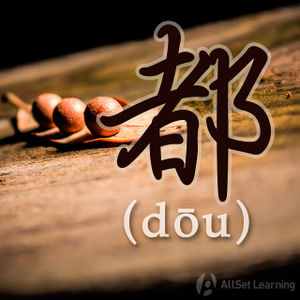Indicating the whole with "quan"
| This article is a stub. Editors can help the Chinese Grammar Wiki by expanding it. |
-
Level
-
Similar to
-
Used for
-
Keywords
One of the uses of 全 (quán) is to indicate the entirety of something. It could be used for something like a whole household, an entire country, the whole world, etc.
Contents
Using 全 before Noun
Structure
The structure is quite simple, just put 全 in front of the noun you want to emphasize "the whole" of. You cannot use it with 的. Pay attention to the types of nouns you can use with 全, since it is usually paired up with 身 (body), 家 (family), 国 (country), 世界 (world), 天 (day) and the like.
全 + Noun + 都 + Verb
Examples
- 我们 全家 都 去 旅游 了。The entire family went traveling.
- 明天 我 全 天 都 呆 在 家里。I am going to stay home all day tomorrow.
- 全 公司 的 人 都 知道 这 件 事 了。The whole company knew about this thing.
- 打 完 球 以后 我 全 身 都 是 汗。My whole body sweat after playing the ball.
- 全世界 的 人 都 知道 Obama 是 谁,你 不 知道?The whole world knows who Obama is. Don't you know?
Using 全都 before Verb
Affirmative Pattern
Before a verb 全 can be omitted, but if it is used, the purpose is to emphasize the idea of "all" or "entire."
Structure
Subj. + 全 + 都 + Verb / Adj.
Examples
- 大家 全 都 到 了。Everybody has come.
- 作业 全 都 做 完 了 吗?You've finished all your homework?
- 我 全 都 听 懂 了。I heard and understood all.
- 你 全 都 拿 走 吧。Take them all.
- 他 把 咖啡 全 都 喝 了。He drank up all the coffee.
Negative Pattern
Structure
When you negate 全都 with 不 or 没, you're not just saying "not entirely," you're saying "none of it" or "not at all."
Subj.+全都+不 / 没+Verb / Adj.
"不、没"在"全都"前面是部分否定, 表示"not all".
Subj.+不 / 没+全都+Verb / Adj.
Examples
- 他们 全 都 没 去。None of them went.
- 这 个 周末 我们 全 都 不 在 家。None of us will be home this weekend.
- 他 说 的 话 全 都 不 要 相信。Don't believe what he says.
- 你们 的 员工 全 都 不 会 说 英语 吗?None of your employees can't speak English?
- 他们 全 都 没 学 过 汉语。None of them have studied Chinese.
See also
- Referring to "all" using "suoyou"
- Expressing "Everyone" with "shei"
- Expressing "All" with "shenme dou"
- Expressing "Every" with "mei" and "dou"
- Emphasizing quantity with "dou"



